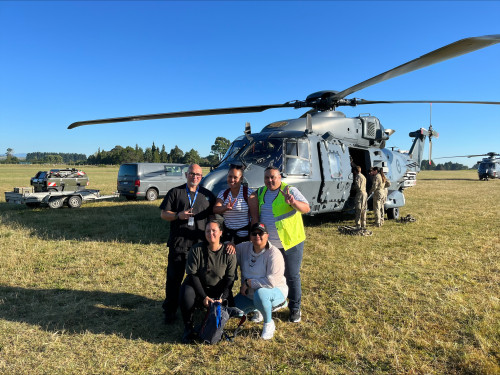
Helicopters loaded with health professionals, medications and a healthy dose of aroha have been providing culturally led, clinically partnered outreach to cut-off rural Hawke’s Bay communities.
Te Whatu Ora Pou Whirinaki Duayne Davies, who led the Isolated Rural Communities āwhina response, says general practitioners (GPs), nurse practitioners, kaiāwhina, psychologists, psychiatrists and mental health workers have visited at least 12 rural communities since the cyclone wreaked havoc on Hawke’s Bay.
“Seeing the need through a cultural lens has been critical to our mission’s success,” Mr Davies says.
Te Whatu Ora has worked in partnership with Te Aka Whai Ora, and alongside New Zealand Defence Force, Civil Defence, NZ Police, Fire Emergency NZ, St John, Ministry of Primary Industries, Ministry of Social Development, Red Cross and Iwī liaisons.
Te Whatu Ora Clinical Lead – Planning and Funding Peter Culham says the team also worked alongside New Zealand Defence Force (NZDF) on its ‘Tūhono’ operation which has located 23 ‘lost whānau’ and is now complete.
“There were a number of places where NZDF were concerned members of the community required emergency assessments so they included our team,” says Dr Culham, who is also a part-time GP.
“Predominantly, primary care was the biggest need we saw, so GPs or nurse practitioners were the ideal people to treat these communities,” Dr Culham says.
“So far, we have records of 200 people seen for medical acute or sub-acute reasons such as skin infections, gastroenteritis, migraines, anxiety, coughs and wound assessments – and then there’s mental health on top of that,” he says.
Mr Davies says ensuring all clinical and psychosocial teams understood the cultural narrative was key to ensuring staff had a clear picture of the community’s healthcare needs.
“Some of the areas heavily populated by Māori took time to open up and engage with clinical staff due to trauma, and they feel more comfortable speaking with whānau Maori,” Mr Davies says. “By ‘cultural’ we are also referring to farming culture, Pasifika, our RSE workers and others - we have to create an environment where they feel safe.”
Te Whatu Ora Pou Whirinaki Hinengaro Anaru Hodges says cultural safety is achieved using the basic principles of Te Ao Māori such as whakawhanaungatanga, mana-enhancing practices such as greeting someone in their language or offering kai, and manaakitanga.
The approach to this outreach was inspired by Māori psychiatrist and author Mason Durie.
“He stated that the synergistic partnering of clinical psychology and cultural intervention can augment recovery from stress or illness, that dwarfs the scope of either acting alone,” Mr Hodges says.
The response teams are seeing a lot of low-level anxiety fuelled by loss of home, land, jobs and income, he says.
“Essentially, their mana has been stripped so we are helping rebuild that, and meeting them where they are.”
Pacific Clinical Lead Noreen Tully, part of the response, says the outreach has been particularly successful for Pasifika.
“Many of our Pacific peoples either don’t have a GP, and if they do, it’s navigating a difficult system that often results in care not being accessed in a timely manner,” Mrs Tully says.
“This is why a Pacific clinical and welfare outreach is so successful.”
Dr Culham says the team is grateful for support from other regions.
“This was an example of a crisis driving change and innovation,” Dr Culham says.
“Finding workforce was a challenge, and we are very grateful to the two psychologists and two administration volunteers from Wellington and Christchurch who have added value.”






Post your comment
Comments
No one has commented on this page yet.